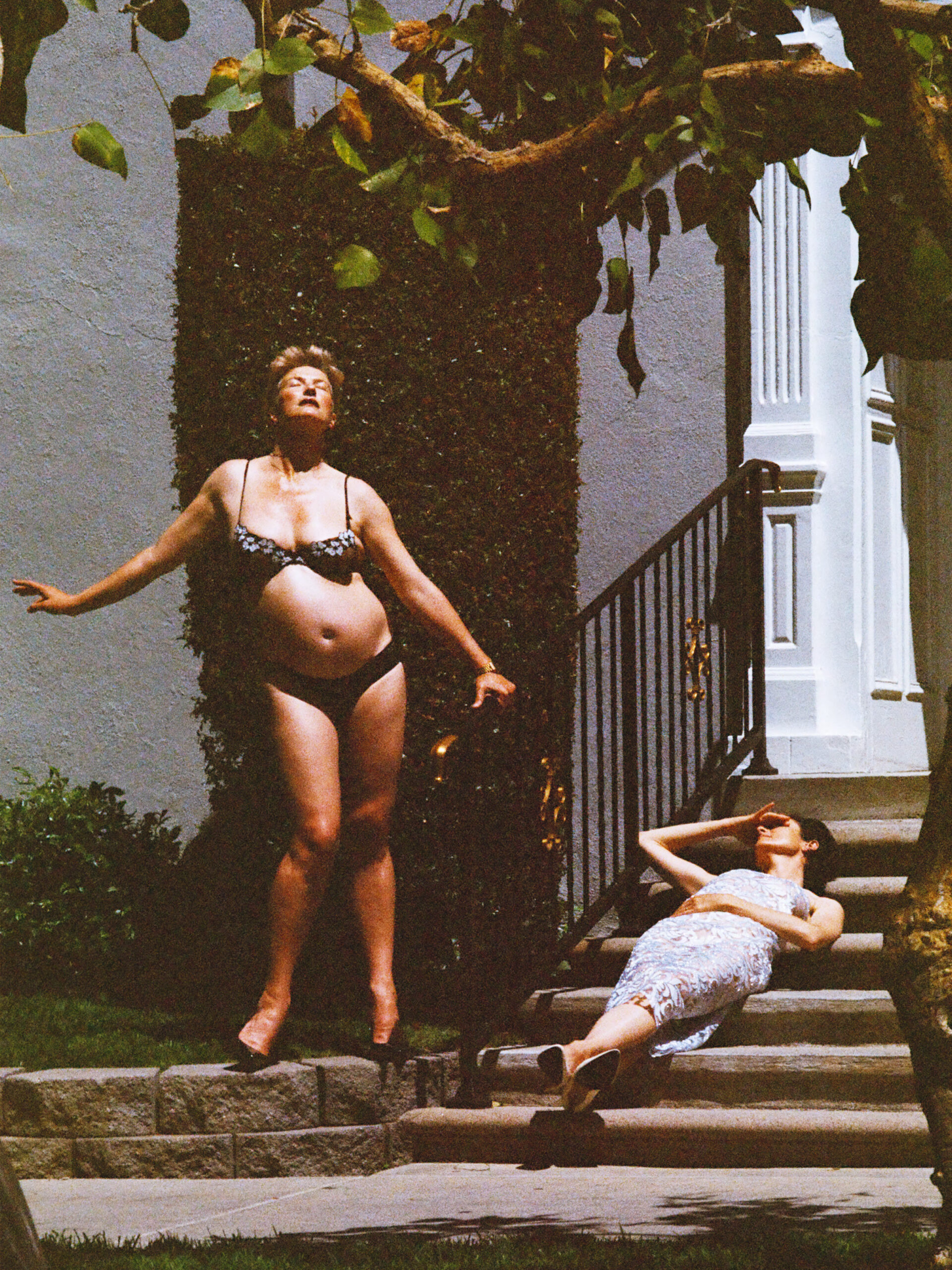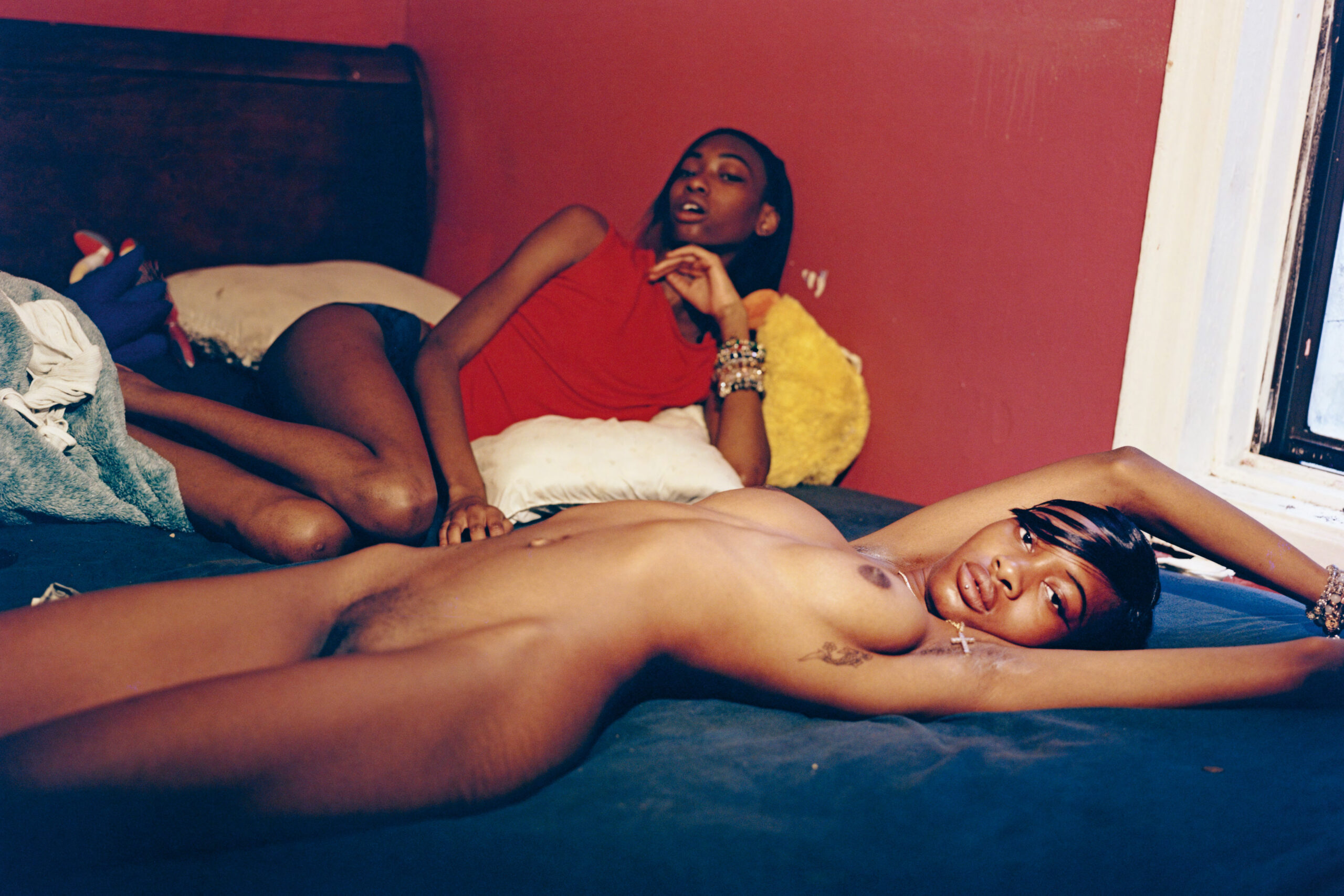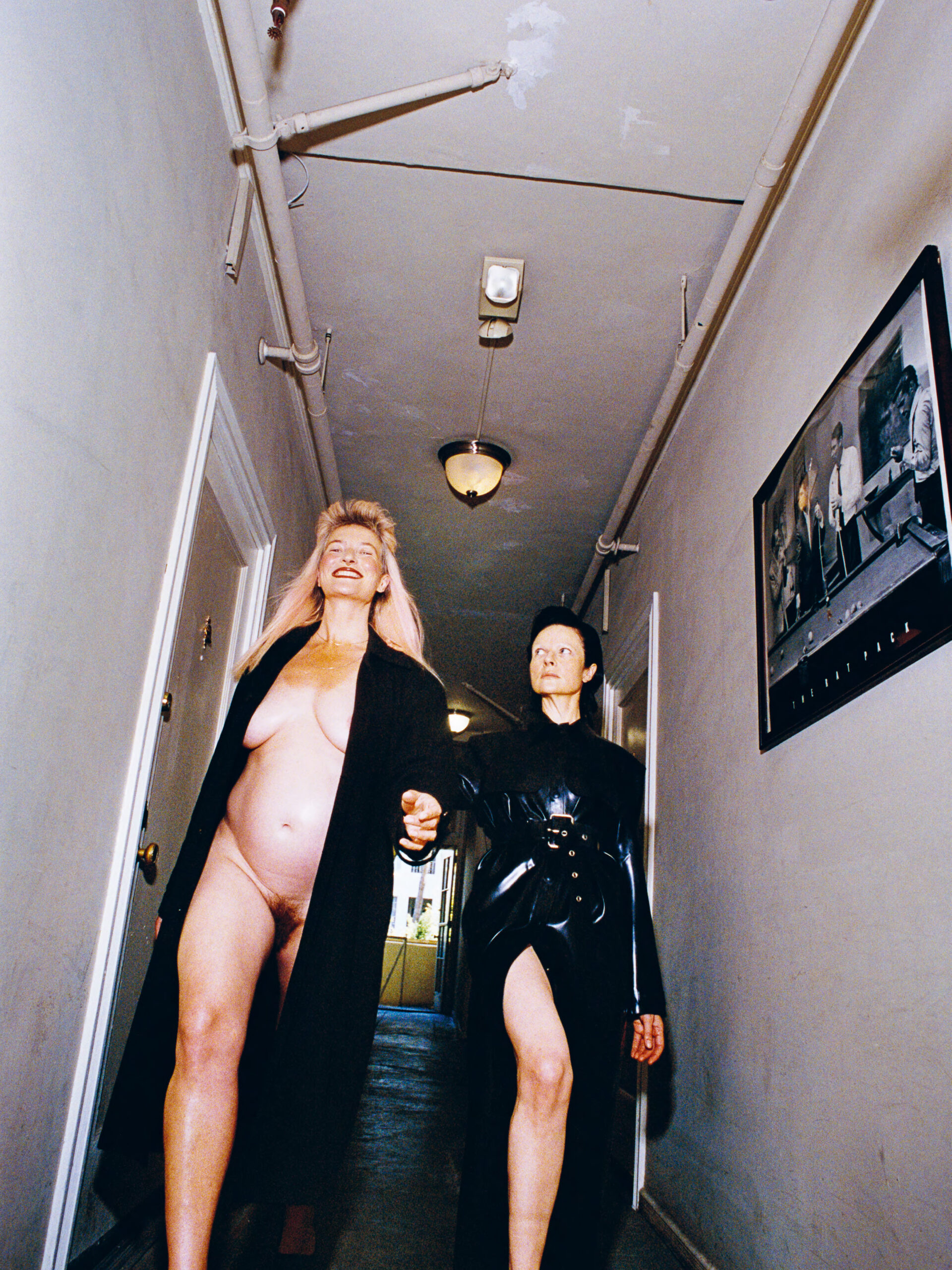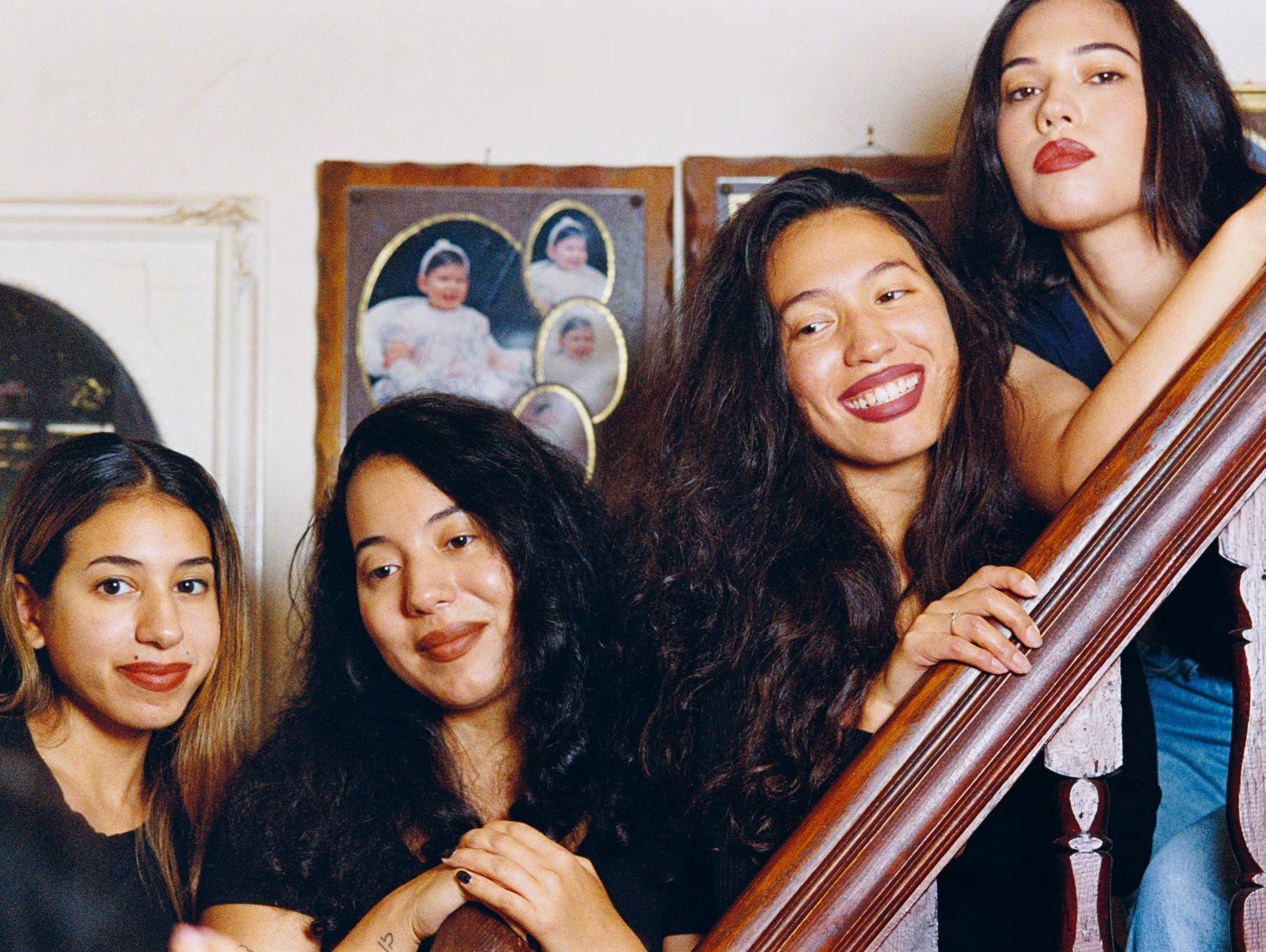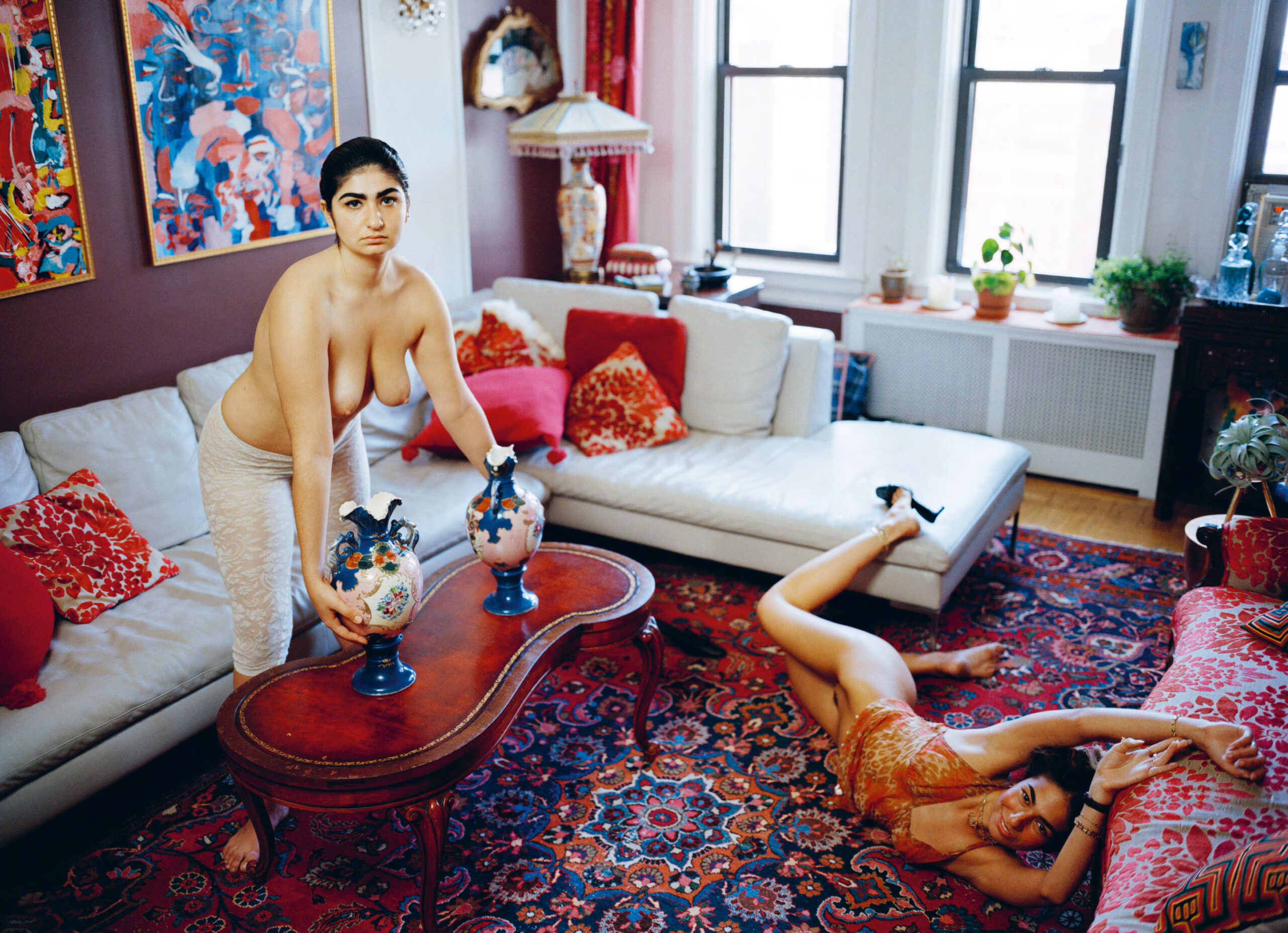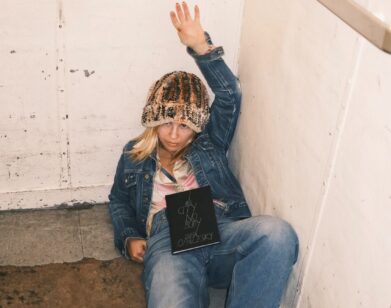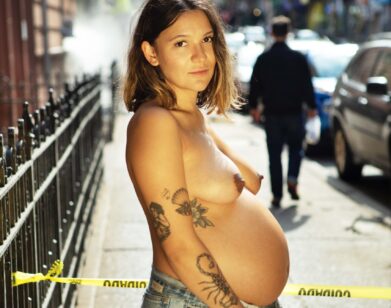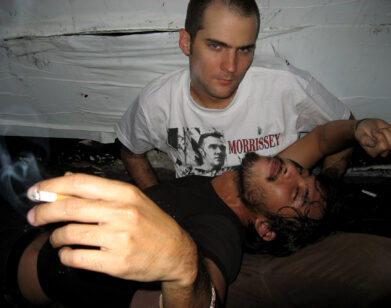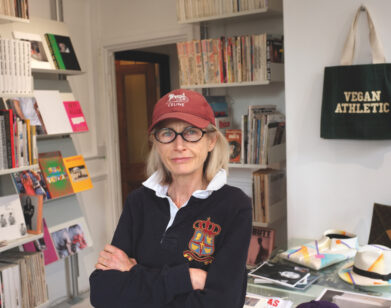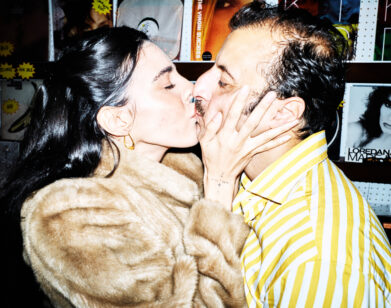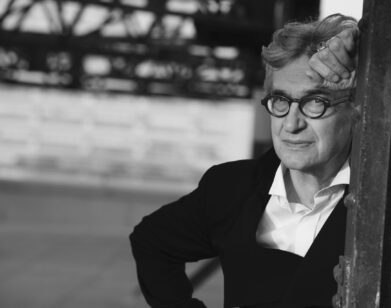SISTERS
Inside Photographer Brianna Capozzi’s Ode to Sisterhood
“That was the most incredible thing,” Brianna Capozzi reminisces, “just to be in the presence of people that are close with one another from birth.” The famed photographer, best known for her work with Dua Lipa, Chloë Sevigny, and Olivia Rodrigo, spent the past six years completing her latest passion project: a photography book titled Sisters. Page after page showcases different pairs of sisters photographed nude and closer than ever in order to tell a story of intimacy, vulnerability, and literal, lifelong friendship. In anticipation of the monograph’s release, Capozzi sat down with longtime collaborator and editor-in-chief of Myth Magazine Haley Wollens to talk boobs, Craigslist, and sibling rivalries.
———
HALEY WOLLENS: I’m going to try to do this without putting all of your dirty laundry out to dry in Interview.
BRIANNA CAPOZZI: I’m nervous.
WOLLENS: The book is beautiful. I’m very proud of you.
CAPOZZI: Thank you.
WOLLENS: You said that you didn’t plan any of the photos in the book, but somehow I don’t believe you. Can you elaborate?
CAPOZZI: Not you debunking my other interviews. Well–
WOLLENS: That’s funny, because actually I didn’t read any of your other interviews. But I read your foreword and I found it really interesting that you said you hadn’t planned any of them. Knowing you, this just didn’t seem true…
CAPOZZI: Well for some reason, I felt so much tension around doing these shoots. I didn’t want to do them and kept putting them off, which is why it took me six years.
WOLLENS: Do you think that was a hesitation around meeting new people and having to go into strangers’ homes?
CAPOZZI: I think it was a chicken or egg thing. Part of it was that I didn’t know what I was really doing yet. And because of that, I didn’t want to do the shoot. I was procrastinating, and I wasn’t planning. Eventually for most of them I was just like, “I’m just going to show up and hope for the best.” I worked on it for six years, and I swear it was only up until last year that I finally stopped feeling that way. My agent was like, “You should put the book out and then stop.” And I was like, “It just took me five years to finally get the ball rolling and trust the process of just showing up, and now I’m actually having fun.” Now I don’t want to stop. I think the fact that I wasn’t planning it is what was giving me the anxiety. I don’t know why I didn’t just sit in front of a computer and pull references, because I could have. I don’t know if I could blame it on being busy with other things, because when I have to do something, I do it, as you know.
WOLLENS: Yeah, I consider you such a planner and it seems so unlike you to go in blindly. With some of the art direction, it seemed hard to believe that that was the spur of the moment. For example, the first image in the book is of the sisters in L.A-I think it’s your friend Kelly.
CAPOZZI: That one was a little bit planned, but only in the sense it was with one of my close friends. We went to the Garment District and I spent a hundred dollars on random stuff and was thinking, “We’ll just figure something out. You picked a good example, because there’s not a lot that I brought. I brought three or four things to all of the shoots. One was the licorice in the baby Sara photo, one was the balloon in Sabrina’s picture. I found some tomatoes in Cassie’s fridge that’s in a picture with my friend Calla, but I didn’t really have a plan.
WOLLENS: I think about our process of our work together, where we love to spend hours planning, but usually it never ever ends up that way. It’s a funny reversal effect. No matter how much you plan, you just plan for chaos.
CAPOZZI: It’s so funny because someone asked me in an interview the other day about the Chloë [Sevigny] lobster photo and that was probably one of our most planned shoots. This is the one time we stuck to our plan, but that’s my defending of my non-planning.
WOLLENS: I believe you.
CAPOZZI: Everyone would be like, “Send your hair and makeup refs.” I booked hair and makeup the day before and if one of them wasn’t available, it was fine.
WOLLENS: Well, clearly you have a thing for using false eyelashes because they’re all over the book. I think I saw them sometimes on nipples. I couldn’t figure out if they had hairy nipples or if they were fake eyelashes.
CAPOZZI: No, those were fake eyelashes. Fara Homidi did that.
WOLLENS: Do you feel like your approach is different now, as going from someone who was quite meticulous about the shot and the pose to having such a freeing experience? Do you feel like you’re changed?
CAPOZZI: I feel like I’ve changed in the sense that I have a new found confidence that I could just show up to an ad job or do an editorial on a whim and make strong images. As much as we hate to admit it, sometimes you just don’t have the time to fully be planning to the extent that we want to. I eventually got to a place where I feel pretty confident that I can take a good picture anywhere. I didn’t think about it that way prior to this.
WOLLENS: I’ve spent a lot of time thinking about these sisterly relationships, and the intimacy we experience as children. We’re in the bath as kids, but eventually we grow up and we’re not naked together anymore. But sisters have this intimacy that is never lost because woman to woman, there’s this comfortness and this openness. How did you arrive at asking people to go nude?
CAPOZZI: Well, I knew that I already had that feeling that me and my sister can be naked or pee in front of each other. In my own experience, there was not a lot of competition between us. I always felt comfortable to be free in a way, even beyond some friendships. I wanted that to be portrayed in the book, and not have it be so stylized and bring it a little bit closer to neutral. Some people, of course, wanted to be clothed. In the beginning I really wanted it to stay nude, but then I didn’t want certain people to not be able to be in it. That was a big learning curve of, what are the clothes going to be saying when they have to be in this book? Obviously my first instinct, as you can imagine yours would be, is “Am I going to do fashion? Am I pulling clothes? Am I getting a stylist?” But it just didn’t make sense, but at the same time I didn’t want them fully dressing themselves in current modern outfits. Sometimes I brought bed sheets or little things that could cover whatever they wanted.
WOLLENS: Thinking about all of the sisters that you shot, is there one thing that they all had in common other than the fact that they were sisters?
CAPOZZI: They all had boobs. No, no, I’m thinking. It’s a hard question. Not really that I can think of. I would say the one thing they all had was that they were close with their sisters. There were definitely people I met who weren’t and were like, “I don’t get along with my sister, we haven’t talked in 10 years, but I have a friend.” And I’d be like “No.”
WOLLENS: Did they all make fun of each other?
CAPOZZI: Definitely not. They all had their own dynamics. That was the most incredible thing, just to be in the presence of people that are close with one another from birth. You know when you have a best friend and she has a sister and you finally meet them. Isn’t that experience wild? You’re like, “Oh my God, this person’s so like you, but not you at all.”
WOLLENS: I thought that one of the most poignant things that you said in your afterward was about how being raised and nurtured in the same environment and turning out so widely different is one of the cosmic mysteries of sisterhood, and I was wondering about your own sister. I know you said that you were so different and there wasn’t a lot of competition, but was there a trait that she had that you didn’t, that you wish you had had growing up?
CAPOZZI: Yeah, her lips and her boobs. [Laughs] No, our personalities are very similar. We have a similar outlook on life, and we’re both pretty positive people who like to do a bunch of things. And our parents are both like that. They’re not sitting at home doing nothing.
WOLLENS: So it wasn’t like she was popular and you weren’t? Was there anything that was easy for her to do that you couldn’t manage to do or just being a little sister?
CAPOZZI: Not really, because I’m into completely different things. She was into dance and I was like, “Thank god I don’t have to go do that.”
WOLLENS: Yeah. Well, the world should know that you grew up as a little boy actually.
CAPOZZI: I did, I grew up as a tomboy.
WOLLENS: But like, really tomboy. I think that’s an interesting part of your story to share. So while you had this sort of great sisterly relationship, you were very different.
CAPOZZI: Definitely.
WOLLENS: It’s not like you were two girls who were going for the same things. You were in two completely different worlds that probably allowed for a certain harmony. I know other sisters who were going to blows over a pair of Mud jeans, you know?
CAPOZZI: For sure, but we did have that too. I got asked in one of the questions, “What is the most annoying part of having a sister?” And I literally said, “They steal your clothes.” I would cry hysterically and be like, “I worked so hard to find those jeans at the mall, and you stole them.” But I think it’s also attributed to our age gap. We’re five years apart, so we were never in the same scenario as one another. My puberty was so far from her puberty. We kind of had the perfect age gap to have no drama. Also, she just isn’t a jealous person. She has never been, even with all my success in my career. We live such different lives and I could be so jealous of her. I’m dying to meet somebody and have a kid, and she has a whole family.
WOLLENS: I really can’t imagine having grown up with another girl in the house. As a woman, we already are comparing ourselves in every way, whether we mean to or not, it’s just how we’re developed. To go back to fighting, I was wondering if you witnessed any big blowouts on the set of any of your shoots between the sisters?
CAPOZZI: No. I noticed sometimes that you could tell the sister who wanted to be doing the shoot and the sister that got talked into doing the shoot. But it was always fine by the end.
WOLLENS: So there were no blowouts over a wig or an outfit?
CAPOZZI: I mean, I would get people ready, and be like, “All right, let’s do this to her, and we’re going to put these lashes on,” and then I’d be like, “I think you’re kind of fine as you are.” And they’d be like, “Wait, what? You want me to have no hair, no makeup, but they get that?” Or even Lexie and Rachel, Rachel got the eyeshadow and her hair.
WOLLENS: Yeah, I’ve always found that image arresting. There’s something really uncomfortable about it. I never really realized that’s what it was, but then you talked about this, how the one sister had the makeup. Once you know that backstory, you can just see the discomfort.
CAPOZZI: Yeah. When I would do these shoots, I wouldn’t know what I was going to go home with. I didn’t know if I was even going to be into it sometimes. Usually we know if we did a good job or not and if we got an amazing picture. I feel like in general with photography, the top photo is so good, and then the photo that comes after drops so many stories. It’s not even close to touching what the best picture is, and that picture for me is one of my favorite photos in the whole book, and it’s because Rachel looks like that. She looks so amazing and slightly disturbed, and it tells a story. I feel like they transformed into completely different characters in that picture. They got removed from who they were a little bit, and that’s really incredible. I don’t remember where that question started.
WOLLENS: Me neither. What was it?
CAPOZZI: If people got annoyed at the–
WOLLENS: Oh, if there were fights on set.
CAPOZZI: Yeah, it was more just that, but they were always down for it. They always believed in me, which was amazing because I didn’t want it to just be some beautiful book of hot girls looking the best they possibly could. That’s not really of interest.
WOLLENS: I’m impressed that you managed to shoot that many sets of sisters without having any blowouts.
CAPOZZI: For sure. I’m sure there’s been blowouts since.
WOLLENS: I was curious how you met. Niko and Gayle
CAPOZZI: Off Craigslist. Gayle contacted me. She’s so fab, and she has another sister too. I was supposed to shoot the three of them, but the other sister backed out at the last minute. She was a little bit nervous in front of the camera. I went to their house, and Niko had been adopted when she was younger, and she’d explained this whole story about how she kind of mothered her a little bit because of her age, and it was incredible. Niko was in a photo program. I should get the footage. She videotaped the whole experience.
WOLLENS: Amazing. That would be a great ad for Myth.
CAPOZZI: It would, you’re very right.
WOLLENS: How many people did you get off of Craigslist?
CAPOZZI: I think they might have been the only ones. I cast so many different avenues. Geraldine [Barón] and Salome [Oggenfuss] for the first few years were sending me these big decks and databases, and it was a struggle to lock in with a lot of those people. There were all these dead ends that I went down with incredible sisters that I would have died to be shooting. I don’t know why, but a lot of it fell through. In the end, I shot only maybe one or two groups from Salome and Geraldine, but they were my favorite sisters in the group. The beautiful Black girls, Tashanna and her sister Amaria in their house. They’re on a couch and also on a pink bed, Tashanna with the cross necklace on.
WOLLENS: In the Bronx.
CAPOZZI: Yeah, and it was really amazing. But from Craigslist, that was only the one. A lot on Instagram.
WOLLENS: Do you have people still reaching out to you?
CAPOZZI: No, but I have this massive database. Everyone’s so curious why I ended up calling it, and you are one of the main people that was like, “You should just do this for two decades,” and I do want to. The women hold their own. You don’t need the concepts and the ideas. You just don’t. I mean, you know me, I’ve got a million different projects up my sleeve that I want to be working on, so the reason I’m not doing that is just for compartmentalization’s sake. I can’t keep a project open like that and actually have room for another one, but maybe I’ll do a second edition and add 10 more girls or something, if the book sells and is of interest.
WOLLENS: I think that that’s a great place to end this.
CAPOZZI: Great. I could do this all day. I’m like, “What else should we say about ourselves?”
WOLLENS: I know. I’m like, “How can we have a conversation without talking shit and revealing our deepest, darkest secrets?”
CAPOZZI: I know. It’s hard.”I want to say everything.” I’m such an open book, but I can’t air everyone’s laundry.
WOLLENS: Well, it’s such a responsibility taking on. I think what makes your documentary photographs so special and so uniquely yours is that you come from a fashion background, and you’re not just a voyeur. In my experience working with documentary photographers, sometimes the way they manage it is just by putting such a wall between them and the subjects, and it’s so obvious in your work that that is not the case. You speak of all the fun that you had, and clearly, that is being had. And clearly, the photographs and interactions are involved. You’re not just there shooting.
CAPOZZI: No, it was so much more of a hangout. That’s the difference between being on set with models or celebrities as opposed to siblings and sisters. It was really family time. Also, I just got an alert that my book is on the second floor of my apartment building. I’m about to see it for the first time in person.
WOLLENS: Amazing!
CAPOZZI: I’m nervous.
WOLLENS: Alright, well, love you, and thank you, and thanks for the thanks at the end of the book.
CAPOZZI: I love you. I love you.
WOLLENS: Talk later.
CAPOZZI: Talk in five seconds. Bye.
WOLLENS: Bye.

